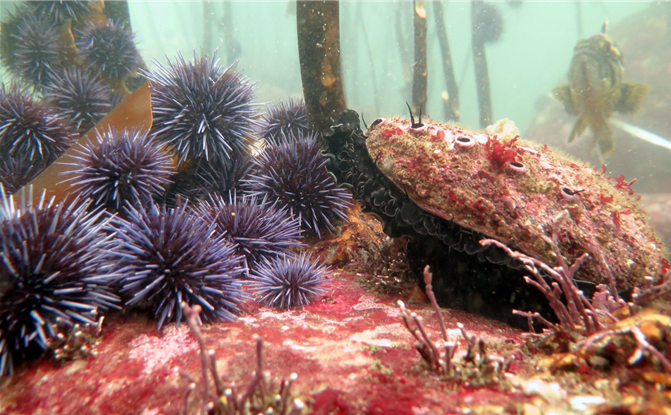
Historically, red abalone populations in nearshore habitats off the California coast supported a large recreational fishery. Since 2014, Northern California’s red abalone population has declined by 80 percent, while purple urchin populations have increased dramatically, resulting in urchin-dominated areas denuded of kelp. This project, led by Noyo Center for Marine Science, outlines a multifaceted approach to address the kelp forest decline in coastal northern California through conservation aquaculture.
What We Are Doing
The Noyo Center for Marine Science, collaborating with partners and stakeholders, aims to promote public awareness of and facilitate scientific progress toward conservation aquaculture approaches to coastal management using a two-pronged plan targeting purple urchin and red abalone.
Building off previous trials, the Purple Urchin Aquaculture Pilot Project will implement a land-based urchin aquaculture system to advance purple urchin aquaculture, potentially laying the foundation for large-scale commercial aquaculture in the future that would create a restorative seafood product and support the local economy. Fed a dense seaweed pellet in constructed urchin “raceways,” harvested
purple urchin will grow marketable roe within 6–10 weeks. Coupled with public facing outreach and partnership with local organizations and restaurants, this project will enhance domestic and local demand for purple urchin as a restorative seafood product.
In partnership with the University of California, Davis’s Bodega Marine Lab and the Kashia Band of Pomo Indians, the Abalone Broodstock Demonstration Project, aims to ensure the survival of the red abalone population — once a $44 million recreational fishery in northern California — by feeding starving abalone in tanks until reproductively viable, spawning them in the lab, growing the larvae to a specific size, and eventually releasing juvenile abalone into restoration zones. While this larger program develops further, there is an urgent need to collect adults now to ensure suitable genetic diversity and to recondition them. Project activities will include the collection of malnourished adults to be raised until they are reproductively viable, a process that can take up to two years.
Benefits of Our Work
This project charts a path toward addressing the deeply interrelated economic and ecological crises facing northern California’s coastal communities through pilot conservation aquaculture projects aimed at the development of purple urchin as a restorative seafood product and the creation of an abalone broodstock to replenish marine habitats.
